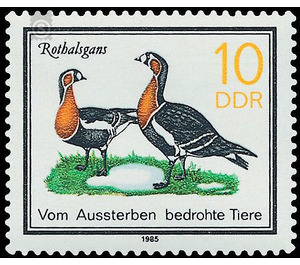Commemorative stamp series - Germany / German Democratic Republic 1985 - 10 Pfennig
Theme: Animals
| Country | Germany / German Democratic Republic |
| Issue Date | 1985 |
| Face Value | 10.00 |
| Color | multi-colored |
| Perforation | K 14 |
| Printing Type | Rotogravure 2 |
| Stamp Type | Postage stamp |
| Item Type | Stamp |
| Chronological Issue Number | 2695 |
| Chronological Chapter | GER-DDR |
| SID | 764397 |
| In 27 Wishlists | |
Animals threatened with extinction With the illustrations of several endangered species, the Ministry of Posts and Telecommunications of the German Democratic Republic issues five multi-colored special postage stamps. Special cancellation from 25th June to 24th August 1985 Animals in danger of extinction 10 Pfennig value: Red-breasted Goose (Branta ruficollis) The red-necked goose, a relatively small member of the genus sea-goose, is characterized by a typical colorful coloring, the reddish-brown, narrow white margined cheek spots and the narrow white bordered reddish-brown breast with forearm. The sexes are externally indistinguishable. The wing measures up to 390 mm, the body mass is usually 1.5 kg or something above it. The red-breasted goose breeds in the wooded tundra of the High North of the USSR from the Ob via the middle Siberia east to the Chatanga. The total population was estimated in 1965 at about 50,000, in 1980 only 30,000 copies. In recent decades there has been a significant shift in wintering grounds. While the majority overwintered earlier on the Caspian and Aral Seas, most of them now mainly visit the Dobruja on the edge of the Danube Delta (Romania). In the Siberian tundra, which is interspersed with waters of different sizes, the red-necked geese are found in loose breeding colonies, which, however, only comprise five to seven, rarely more pairs. The nests are elevated, mostly over steep slopes. The eggs receive three to six, rarely to nine eggs, which are incubated for 24 to 26 days. In human custody, this beautiful goose is fortunately already seen quite often, in the GDR both in some zoos and in individual breeders of the SZG "Ziergeflügel and exotics" at the VKSK. This is due to the fact that the species could be repeatedly brought to breeding, so since 1971 in Tierpark Berlin.


